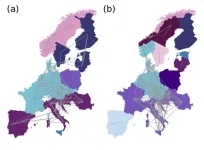(Press-News.org) EDMONTON — A new groundbreaking study sheds light on a medical question scientists have long wondered: why do 40 per cent of children with the rare neurodevelopmental disorder KBG syndrome have heart defects? The research now points to a critical link between the heart and the brain.
KBG syndrome can cause unusual facial development, skeletal abnormalities, intellectual underdevelopment and heart defects. The syndrome is caused by mutations in the ANKRD11 gene, which plays a crucial role in brain development, but it wasn’t until now that researchers at the University of Alberta also found a tie between the gene and the heart, including problems with heart valves and the walls between heart chambers.
Anastassia Voronova, an associate professor in the Faculty of Medicine and Dentistry, led the study, with cutting-edge Vizgen Merscope technology and the U of A’s Core Research Facilities team.
Voronova's team observed that mice with the ANKRD11 gene removed from their neural crest cells — a critical part of heart development — had abnormal heart formation and function, including inefficient blood circulation due to the heart’s outflow tract not properly forming, and enlarged heart ventricles which affected the heart’s ability to pump blood. Several important signalling pathways were also affected, impacting cell function and development.
This team’s research follows their previous work published earlier this year, which showed the importance of ANKRD11 to the development of brain cells. These findings in mice were also found in KBG syndrome patients, leading to the discovery of a novel clinical phenotype — the absence of smell.
The next steps are to investigate how the heart and brain influence each other’s development in children with KBG syndrome to develop better clinical care and treatment. The study's findings, along with other recent work in this area, have already started to influence clinical practices: heart evaluations are now recommended for children diagnosed with KBG syndrome.
“The problem with rare disorders is that not all patients are evaluated the same way across the world,” says Voronova. “By showing a clear role of ANKRD11 in heart development, our work paves the way for including heart evaluations in clinical guidelines across the world. This will help to ensure every child diagnosed with KBG syndrome will have their heart evaluated and corrected in a timely manner if needed.”
More information can be found here. To speak with Anastassia Voronova, please contact:
Sarah Vernon | University of Alberta communications associate | svernon@ualberta.ca
END
Groundbreaking University of Alberta study discovers connection between between heart and brain in KBG syndrome
Promising research looks at how gene mutations — already known to impact brain development — can also cause heart defects in those with the rare disorder
2024-07-02
ELSE PRESS RELEASES FROM THIS DATE:
Optoelectronics gain spin control from chiral perovskites and III-V semiconductors
2024-07-02
A research effort led by scientists at the U.S. Department of Energy’s (DOE’s) National Renewable Energy Laboratory (NREL) has made advances that could enable a broader range of currently unimagined optoelectronic devices.
The researchers, whose previous innovation included incorporating a perovskite layer that allowed the creation of a new type of polarized light-emitting diode (LED) that emits spin-controlled photons at room temperature without the use of magnetic fields or ferromagnetic contacts, now have gone a step further by integrating a III-V semiconductor ...
Doctors could soon use facial temperature for early diagnosis of metabolic diseases
2024-07-02
A colder nose and warmer cheeks may be a telltale sign of rising blood pressure.
Researchers discovered that temperatures in different face regions are associated with various chronic illnesses, such as diabetes and high blood pressure. These temperature differences are not easily perceptible by one’s own touch but can instead be identified using specific AI-derived spatial temperature patterns that require a thermal camera and a data-trained model. The results appear July 2 in the journal Cell Metabolism. With ...
Engineered plasma cells show long-lasting antileukemic activity in mice
2024-07-02
Researchers show for the first time that engineered human plasma B cells can be used to treat a disease—specifically leukemia—in a humanized animal model. The results mark a key step in the realization of ePCs as therapies to treat cancer, auto-immune disorders, and protein deficiency disorders. The results appear July 2 in the journal Molecular Therapy.
“We hope that this proof-of-concept study is the first of many applications of engineered plasma B cells, and eventually will lead to a single-shot therapeutic,” says senior study author Richard James (@ScienceRicker) of the Seattle Children’s ...
Proteins and fats can drive insulin production for some, paving way for tailored nutrition
2024-07-02
When it comes to managing blood sugar levels, most people think about counting carbs. But new research from the University of British Columbia shows that, for some, it may be just as important to consider the proteins and fats in their diet.
The study, published today in Cell Metabolism, is the first large-scale comparison of how different people produce insulin in response to each of the three macronutrients: carbohydrates (glucose), proteins (amino acids) and fats (fatty acids).
The findings reveal that production of the blood sugar-regulating hormone insulin is much more dynamic and individualized than previously ...
Melting of Alaskan glaciers accelerating faster than previously thought
2024-07-02
Melting of glaciers in a major Alaskan icefield has accelerated and could reach an irreversible tipping point earlier than previously thought, new research suggests.
The research, led by scientists at Newcastle University, UK, found that glacier loss on Juneau Icefield, which straddles the boundary between Alaska and British Columbia, Canada, has increased dramatically since 2010.
The team, which also included universities in the UK, USA and Europe, looked at records going back to 1770 and identified three distinct periods in how icefield volume changed. They saw that glacier volume loss remained fairly ...
Genetic study points to oxytocin as possible treatment for obesity and postnatal depression
2024-07-02
Scientists have identified a gene which, when missing or impaired, can cause obesity, behavioural problems and, in mothers, postnatal depression. The discovery, reported today in Cell, may have wider implications for the treatment of postnatal depression, with a study in mice suggesting that oxytocin may alleviate symptoms.
Obesity and postnatal depression are significant global health problems. Postnatal depression affects more than one in 10 women within a year of giving birth and is linked to an increased risk of ...
What was behind the 2021-2022 energy crisis within Europe?
2024-07-02
WASHINGTON, July 2, 2024 – An energy crisis hit Europe in 2021-2022, following Russia’s invasion of Ukraine, which sent electricity prices skyrocketing — even within countries that don’t rely on Russian gas. It begs the question: Was there more to it?
A team of researchers from the Institute for Energy and Climate Research at Forschungszentrum Jülich, the University of Cologne, and the Norwegian University of Life Sciences had already been working with electricity price data for years, exploring statistics and developing forecasting methods. Adopting a European perspective, ...
Alterations in human gene TRPC5 cause obesity and postpartum depression
2024-07-02
Researchers at Baylor College of Medicine, the University of Cambridge and collaborating institutions have discovered that alterations in the human gene TRPC5 cause obesity and postpartum depression.
Taken together, their studies in cells, animal models and humans showed that TRPC5 acts on distinct neuronal populations in the hypothalamus, a brain region that regulates multiple innate behaviors including feeding, anxiety, socialization and maternal care. The findings, published in the journal Cell, ...
In-hospital delirium and disability and cognitive impairment after COVID-19 hospitalization
2024-07-02
About The Study: In this cohort study of 311 hospitalized older adults with COVID-19, in-hospital delirium was associated with increased functional disability and cognitive impairment over the 6 months following discharge. Older survivors of a COVID-19 hospitalization who experience in-hospital delirium should be assessed for disability and cognitive impairment during postdischarge follow-up.
Corresponding author: To contact the corresponding author, Lauren E. Ferrante, M.D., M.H.S., email lauren.ferrante@yale.edu.
To access the embargoed study: Visit our For The Media website at this link https://media.jamanetwork.com/
(doi: 10.1001/jamanetworkopen.2024.19640)
Editor’s ...
E-cigarette use and lung cancer screening uptake
2024-07-02
About The Study: In this cross-sectional study, e-cigarette use was independently associated with lower use of lung cancer screening, particularly among individuals who had quit smoking combustible cigarettes. Emerging research suggests that e-cigarettes contain definite and probable carcinogens and cause similar cancer-associated gene deregulations as combustible tobacco.
Corresponding author: To contact the corresponding author, Qian Wang, M.D., M.P.H., email qian.wang@uhhospitals.org.
To access the embargoed study: Visit our For The Media website at this link https://media.jamanetwork.com/
(doi: ...
LAST 30 PRESS RELEASES:
A new way to map how cells choose their fate
Numbers in our sights affect how we perceive space
SIMJ announces global collaborative book project in commemoration of its 75th anniversary
Air pollution exposure and birth weight
Obstructive sleep apnea risk and mental health conditions among older adults
How talking slows eye movements behind the wheel
The Ceramic Society of Japan’s Oxoate Ceramics Research Association launches new international book project
Heart-brain connection: international study reveals the role of the vagus nerve in keeping the heart young
Researchers identify Rb1 as a predictive biomarker for a new therapeutic strategy in some breast cancers
Survey reveals ethical gaps slowing AI adoption in pediatric surgery
Stimulant ADHD medications work differently than thought
AI overestimates how smart people are, according to HSE economists
HSE researchers create genome-wide map of quadruplexes
Scientists boost cell "powerhouses" to burn more calories
Automatic label checking: The missing step in making reliable medical AI
Low daily alcohol intake linked to 50% heightened mouth cancer risk in India
American Meteorological Society announces Rick Spinrad as 2026 President-Elect
Biomass-based carbon capture spotlighted in newly released global climate webinar recording
Illuminating invisible nano pollutants: advanced bioimaging tracks the full journey of emerging nanoscale contaminants in living systems
How does age affect recovery from spinal cord injury?
Novel AI tool offers prognosis for patients with head and neck cancer
Fathers’ microplastic exposure tied to their children’s metabolic problems
Research validates laboratory model for studying high-grade serous ovarian cancer
SIR 2026 delivers transformative breakthroughs in minimally invasive medicine to improve patient care
Stem Cell Reports most downloaded papers of 2025 highlight the breadth and impact of stem cell research
Oxford-led study estimates NHS spends around 3% of its primary and secondary care budget on the health impacts of heat and cold in England
A researcher’s long quest leads to a smart composite breakthrough
Urban wild bees act as “microbial sensors” of city health.
New study finds where you live affects recovery after a hip fracture
Forecasting the impact of fully automated vehicle adoption on US road traffic injuries
[Press-News.org] Groundbreaking University of Alberta study discovers connection between between heart and brain in KBG syndromePromising research looks at how gene mutations — already known to impact brain development — can also cause heart defects in those with the rare disorder

